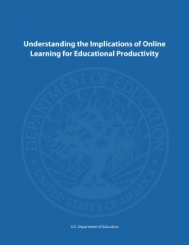Promoting Grit, Tenacity, and Perseverance - U.S. Department of ...
Promoting Grit, Tenacity, and Perseverance - U.S. Department of ...
Promoting Grit, Tenacity, and Perseverance - U.S. Department of ...
Create successful ePaper yourself
Turn your PDF publications into a flip-book with our unique Google optimized e-Paper software.
Draft<br />
Importantly, we are deliberate not to treat these factors as residing only within the student—it is<br />
the responsibility <strong>of</strong> the educational community to explore how to design learning environments<br />
that promote these factors.<br />
What will it take to shift educational priorities to promote not only content knowledge, but also<br />
grit, tenacity, <strong>and</strong> perseverance? This is an important <strong>and</strong> exciting time to take stock <strong>and</strong> prepare<br />
to move forward. While the United States faces many critical issues in education, new <strong>and</strong><br />
emerging trends in research, policy, programs, <strong>and</strong> technology are providing unprecedented<br />
opportunities in this domain. At the same time, there remain unanswered questions about the<br />
extent to which grit, tenacity, <strong>and</strong> perseverance are malleable <strong>and</strong> teachable, how to measure<br />
these factors, <strong>and</strong> how to design learning environments that promote them.<br />
The purpose <strong>of</strong> this brief is to distill the critical themes, questions, conclusions, <strong>and</strong><br />
recommendations around theory, measurement, <strong>and</strong> the design <strong>of</strong> learning environments, with<br />
an eye toward identifying potential new roles for technology. It explores the possibility that grit,<br />
tenacity, <strong>and</strong> perseverance can be malleable <strong>and</strong> teachable, <strong>and</strong> discusses the potential <strong>of</strong> these<br />
factors to significantly increase success for all students. Theoretical foundations are grounded in<br />
reviews written primarily for research audiences, most released within the last year. This<br />
information is complemented by interviews with a broad spectrum <strong>of</strong> expert informants from<br />
practice, research, <strong>and</strong> policy domains. Investigations review <strong>and</strong> organize the empirical research<br />
<strong>and</strong> a range <strong>of</strong> approaches to measurement <strong>and</strong> intervention. The brief is also closely tied to<br />
themes in the Exp<strong>and</strong>ing Evidence report, which explores new <strong>and</strong> emerging opportunities<br />
available in an era <strong>of</strong> rapidly evolving <strong>and</strong> exp<strong>and</strong>ing technology (U.S. <strong>Department</strong> <strong>of</strong> Education<br />
Office <strong>of</strong> Educational Technology, 2013). It culminates in key conclusions <strong>and</strong> recommendations<br />
for practitioners, researchers, <strong>and</strong> policymakers.<br />
For the remainder <strong>of</strong> this chapter, we provide an overview <strong>of</strong> the state <strong>of</strong> the field <strong>and</strong> lay out our<br />
research questions <strong>and</strong> methods.<br />
A Critical Need in Education: Why <strong>Grit</strong>, <strong>Tenacity</strong>, <strong>and</strong> <strong>Perseverance</strong>?<br />
American children in the 21st century need support as they encounter a variety <strong>of</strong> challenges<br />
unprecedented in history. As the world becomes increasingly complex, technical, multicultural,<br />
<strong>and</strong> competitive, children <strong>and</strong> adolescents also face a weakening <strong>of</strong> the family <strong>and</strong> informal<br />
community support that was once available. As discussed in more detail in the callout box<br />
below, students in high-poverty areas face particular challenges <strong>of</strong> stress, limited social support,<br />
lack <strong>of</strong> critical resources, <strong>and</strong> psychological disempowerment <strong>and</strong> disenfranchisement. These<br />
issues contribute to dramatic gaps in achievement that are detrimental to individuals <strong>and</strong><br />
corrosive to society as a whole. It is especially important to design learning environments for<br />
these types <strong>of</strong> students that provide contextual supports to persevere through the challenges <strong>of</strong><br />
2
















